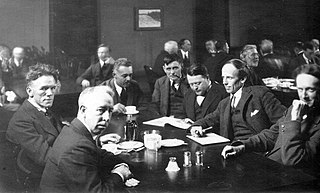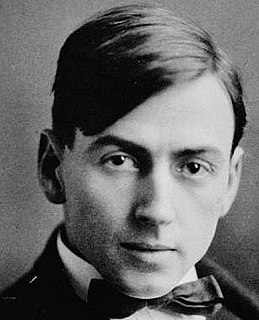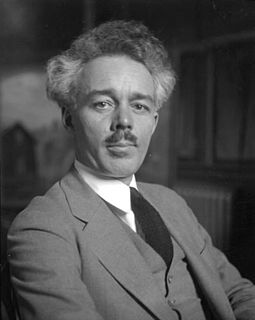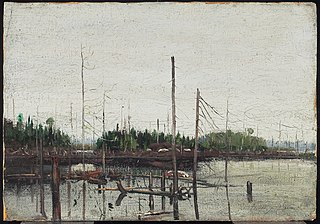
The Group of Seven, once known as the Algonquin School, was a group of Canadian landscape painters from 1920 to 1933, originally consisting of Franklin Carmichael (1890–1945), Lawren Harris (1885–1970), A. Y. Jackson (1882–1974), Frank Johnston (1888–1949), Arthur Lismer (1885–1969), J. E. H. MacDonald (1873–1932), and Frederick Varley (1881–1969). Later, A. J. Casson (1898–1992) was invited to join in 1926, Edwin Holgate (1892–1977) became a member in 1930, and LeMoine FitzGerald (1890–1956) joined in 1932.

Thomas John Thomson was a Canadian artist active in the early 20th century. During his short career, he produced roughly 400 oil sketches on small wood panels and approximately 50 larger works on canvas. His works consist almost entirely of landscapes, depicting trees, skies, lakes, and rivers. He used broad brush strokes and a liberal application of paint to capture the beauty and colour of the Ontario landscape. Thomson's accidental death by drowning at 39 shortly before the founding of the Group of Seven is seen as a tragedy for Canadian art.

The National Gallery of Canada, located in the capital city of Ottawa, Ontario, is Canada's national art museum. The museum's building takes up 46,621 square metres (501,820 sq ft), with 12,400 square metres (133,000 sq ft) of space used for exhibiting art. It is one of the largest art museums in North America by exhibition space.

The Art Gallery of Ontario is an art museum in Toronto, Ontario, Canada. The museum is located in the Grange Park neighbourhood of downtown Toronto, on Dundas Street West between McCaul and Beverley streets just east of Chinatown. The museum's building complex takes up 45,000 square metres (480,000 sq ft) of physical space, making it one of the largest art museums in North America and the second-largest art museum in Toronto after the Royal Ontario Museum. In addition to exhibition spaces, the museum also houses an artist-in-residence office and studio, dining facilities, event spaces, gift shop, library and archives, theatre and lecture hall, research centre, and a workshop.

Alexander Young Jackson LL. D. was a Canadian painter and a founding member of the Group of Seven. Jackson made a significant contribution to the development of art in Canada, and was instrumental in bringing together the artists of Montreal and Toronto. He helped found the Group of Seven in 1920. In addition to his work with the Group of Seven, his long career included serving as a war artist during World War I (1917–19) and teaching at the Banff School of Fine Arts, from 1943 to 1949. In his later years he was artist-in-residence at the McMichael Canadian Art Collection in Kleinburg, Ontario.

Lawren Stewart Harris LL. D. was a Canadian painter, best known as a leading member of the Group of Seven. He played a key role as a catalyst in Canadian art and as a visionary in Canadian landscape art.

James Edward Hervey MacDonald (1873–1932) was an English-Canadian artist, best known as a member of the Group of Seven who asserted a distinct national identity combined with a common heritage stemming from early modernism in Europe in the early twentieth century. He was the father of the illustrator, graphic artist and designer Thoreau MacDonald.

The Jack Pine is a well-known oil painting by Canadian artist Tom Thomson. A representation of the most broadly distributed pine species in Canada, it is considered an iconic image of the country's landscape, and is one of the country's most widely recognized and reproduced artworks.
William Ronald Smith, known professionally as William Ronald, was an important Canadian painter, best known as the founder of the influential Canadian abstract art group Painters Eleven in 1953 and for his abstract expressionist "central image" paintings. He was the older brother of painter John Meredith (1933–2000).

Painters Eleven was a group of abstract artists active in Canada between 1953 and 1960. They are associated with the Abstract Expressionist movement.

John Hamilton Bush was a Canadian abstract painter. A member of Painters Eleven, his paintings are associated with the Color Field movement and Post-painterly Abstraction. Inspired by Henri Matisse and American abstract expressionist painters like Helen Frankenthaler and Morris Louis, Bush encapsulated joyful yet emotional feelings in his vibrant paintings, comparing them to jazz music. Clement Greenberg described him as a "supreme colorist", along with Kenneth Noland in 1984.
Harold Klunder is a Canadian painter.

Canadian art refers to the visual as well as plastic arts originating from the geographical area of contemporary Canada. Art in Canada is marked by thousands of years of habitation by Indigenous peoples followed by waves of immigration which included artists of European origins and subsequently by artists with heritage from countries all around the world. The nature of Canadian art reflects these diverse origins, as artists have taken their traditions and adapted these influences to reflect the reality of their lives in Canada.
Ian A. C. Dejardin is an art historian who was director of the Dulwich Picture Gallery in Dulwich, England. In August 2016 Dulwich Picture Gallery announced that he would be leaving to become chief executive of the McMichael Canadian Art Collection in Ontario in April 2017. He is married to Eric Pearson, his partner since 1987, and lives in Toronto, Canada.
Gershon Iskowitz was a Canadian artist of Jewish background originally from Poland. Iskowitz was a Holocaust survivor of the Kielce Ghetto, who was liberated at Buchenwald. The circumstances of his early life—the trauma of the Holocaust and the uncertainty of the immediate postwar period, followed by immigration and adaptation to Canada—provide a lens through which to understand and appreciate his work. His early figurative images represent his tragic observed and remembered experiences while his later luminous abstract works represent his own unique vision of the world. Iskowitz's work does not easily fit into contemporary schools and movements, but it has been characterized as hard-edge, minimalist, abstract expressionist, and action painting.

Tom Thomson (1877–1917) was a Canadian painter from the beginning of the 20th century. Beginning from humble roots, his development as a career painter was meteoric, only pursuing it seriously in the final years of his life. He became one of the foremost figures in Canadian art, leaving behind around 400 small oil sketches and around fifty larger works on canvas.

Spring Ice is a 1915–16 oil painting by Canadian painter Tom Thomson. The work was inspired by a sketch completed on Canoe Lake in Algonquin Park. The completed canvas is large, measuring 72.0 × 102.3 cm. Painted over the winter of 1915–16, it was completed in Thomson's shack behind the Studio Building in Toronto. The painting was produced as he was in the peak of his short art career and is considered one of his most notable works. While exhibited in a show put on by the Ontario Society of Artists, the work received mixed to positive reviews. In 1916 it was purchased by the National Gallery of Canada in Ottawa and has remained in the collection ever since.

Drowned Land is a 1912 oil sketch by the 20th-century Canadian painter Tom Thomson.
Richard Gorman was a Canadian painter and printmaker. He was known for his magnetic prints which he created using ink covered ball-bearings manipulated with a magnet held behind the drawing board and for his large paintings in which he broadly handled paint.
Thomas Earl Benner was a Canadian sculptor of large sculptures, a painter and an installation artist who explored such themes as the environment, history and nature. His work was widely exhibited in Canada and the United States in public galleries and even in unconventional places, such as Union Station in Toronto. He is associated with a movement in Canadian art known as London Regionalism, which took place in the city of London, Ontario, where he was born and lived.












